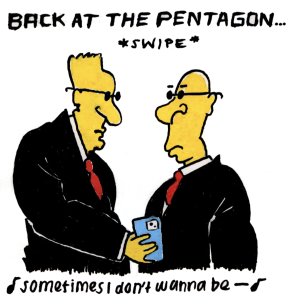In addition to aesthetic appeal, the artwork of Adnan Charara humorously comments on the nature of humanity through subliminal ideas equally provocative and profound. Adnan Charara, an internationally acclaimed artist who promotes tolerance and individual identity through his art, was recently welcomed to Whitman College. His exhibit titled Osmosis I & II is being displayed at the Sheehan Art Gallery through November 16.
Dawn Forbes, the Interim Director of the Sheehan Art Gallery, articulated that “[Charara’s] work occupies the contemporary sphere while still drawing on the rich traditions of African art and Islamic calligraphy as well as European Modernist artists. His work stands as an inspiring example of the beauty, energy and depth that can emerge from a multi-cultured life experience.”
Born in South Africa, Charara moved to the United States when he was 19 to pursue architecture. Although Charara’s parents provided for his education, they did not support his artistic inclinations. The likelihood that he would be successful as an architect was far greater than that of an artist. However, Charara soon realized the impossibility of ignoring his desire to pursue art. Years later, Charara proved his capabilities by eventually receiving global recognition and appreciation as an artist.
Coming from a diverse cultural background, Charara never felt that people truly understood him. Art provided a venue to communicate more effectively his opinion of highly-contested issues in a more favorable and appreciated environment. “Drawing is a universal language,” Charara stated.
As an Arab American, Charara views his art as “a bridge between the east and the west.”
The artist, who has described himself as “a visual poet”, communicates his perspective through figurines and paintings infused with symbolism. Charara embraces overlooked objects, “giving them a new freedom – a new birth” by reworking them. Through the figurine titled Iron Man, Charara comments on the resilience needed to fight the constant bombardment of societal pressure and daily distractions. He humorously reflects upon the interminability of desire through the figurine titled I Want, I Want. “Americans are slaving for material things that they just do not need,” he said.
“Charara’s artistic dialogue often references the dual possibilities of human potential,” said Forbes.
Robin Lewis, a sophomore and environmental studies major who works in the gallery, commented on Charara’s paintings as “reflecting humanity through a variety of patterns and textures”, ultimately reflecting upon the “complexity and multi-faceted nature of an individual”.
“This commonality [that all humans share] is expressed in the repetition of the human form […] printed over and over. Each figure has a rich internal landscape of materials collaged into the form,” Forbes similarly observed.
Regardless of the nuances of personal interpretation, viewers should “[absorb] his creative osmotic processing of experiences [and] carry this positive force in [their] own consciousness and out into the world beyond the walls of the gallery,” said Forbes.
When introducing his exhibit at the Sheehan Art Gallery, Charara offered up words of encouragement to his audience.
“It is up to you to use your knowledge constructively and not destructively, so we can surely keep pouring color and rich wisdom to the foundation of our great nation,” he said.










